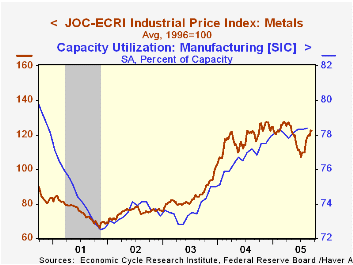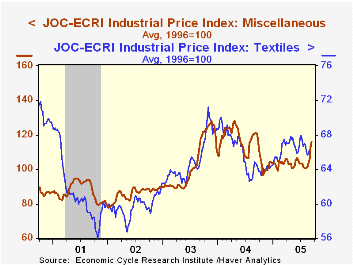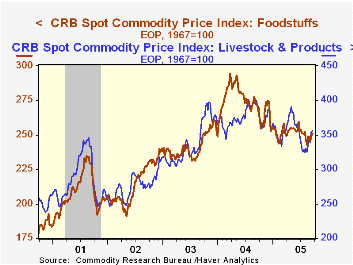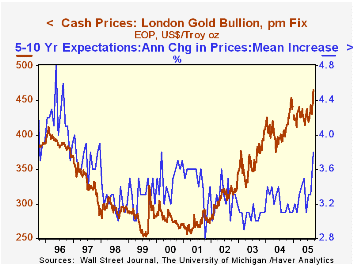 Global| Sep 23 2005
Global| Sep 23 2005Before The Storms: Commodity Prices On The Rise
by:Tom Moeller
|in:Economy in Brief
Summary
A recent focus in commodity markets has been on the damage to petroleum drilling & refining facilities caused by Hurricane Katrina and potentially from Hurricane Rita as well as the resultant price effects. Indeed, versus before [...]

A recent focus in commodity markets has been on the damage to petroleum drilling & refining facilities caused by Hurricane Katrina and potentially from Hurricane Rita as well as the resultant price effects. Indeed, versus before Katrina the Journal of Commerce (JoC)-ECRI index of industrial commodity prices was up 6.0% through last week and likely rose further this week. Much of the rise was caused by a 8.7% rise in petroleum products' prices.
Though crude oil prices rose only 2.5% (45.2% y/y), spot gasoline prices tacked on another 5.2% (49.5% y/y) in September vs. the August average. Daily prices for unleaded regular gasoline rose 6 cents yesterday after an 8 cent rise on Wednesday but, at $2.08 per gallon, the price was well below the late August high of $3.13. Natural gas prices in September have risen more than one quarter versus August (123% y/y).
Elsewhere in commodities markets, prices have not been quiet. Reflecting the strong metals market, the JoC metals price index rose 3.6% in September vs. August (4.1% y/y) bolstered by an 18% (-3.5% y/y) gain in steel scrap prices, a 7.5% (39.6% y/y) rise in zinc prices and a 2.2% (41.9% y/y) increase in copper scrap. During the last twenty years there has been a 43% correlation between the six month change in metal prices and the change in factory sector industrial production
Textile prices in September have risen just 0.7% (3.4% y/y) led by a 2.1% (-3.0% y/y) gain in cotton prices, but there have been fireworks in the miscellaneous category. Down year to year, prices for "miscellaneous" commodities rose 10% in September versus August. Structural composite panel prices rose more than one third vs. August (-5.0% y/y), framing lumber prices increased 2.7% (-13.3% y/y) while rubber prices bounced 8.2% (36.5% y/y).
Foodstuff market prices have been generally quiet as indicated by a little change year to date in the Commodity Research Bureau's food price index. Despite volatility in livestock markets, prices are 10% lower than last year reflecting lower pork costs and beef prices which have stabilized after earlier declines.
Ever the barometer of inflation expectations, gold prices surged more than 10% during the last two months to over $460/oz. in London. That's still slightly below the 20 Year high of just under $500/oz., but the elevated level of gold prices during the last few years clearly reflects a worry that the strength in energy prices will spill further into underlying inflation. In the latest University of Michigan survey, expectations for price inflation during the next five to ten years rose to 3.8% versus an expectation during 2004 of 3.2%.
Gold Prices, a 1999 article from the Federal Reserve Bank of Cleveland is available here.
Forecasts, Indicators, And Monetary Policy is a 1999 study from the Federal Reserve Bank of Philadelphia and can be found here.
| JoC-ECRI Industrial Price Index | 09/16/05 | 12/31/04 | Y/Y | 2004 | 2003 | 2002 |
|---|---|---|---|---|---|---|
| All Items | 120.50 | 111.60 | 3.3% | 112.78 | 91.97 | 79.53 |
| Textiles | 66.70 | 64.40 | 3.4% | 65.83 | 65.09 | 59.73 |
| Metals | 122.40 | 124.60 | 4.1% | 118.15 | 84.57 | 75.14 |
| Miscellaneous | 115.9 | 113.7 | -4.0% | 114.0 | 102.9 | 85.8 |
| Petroleum Products | 285.7 | 279.5 | 22.4% | 207.1 | 135.3 | 110.1 |
Tom Moeller
AuthorMore in Author Profile »Prior to joining Haver Analytics in 2000, Mr. Moeller worked as the Economist at Chancellor Capital Management from 1985 to 1999. There, he developed comprehensive economic forecasts and interpreted economic data for equity and fixed income portfolio managers. Also at Chancellor, Mr. Moeller worked as an equity analyst and was responsible for researching and rating companies in the economically sensitive automobile and housing industries for investment in Chancellor’s equity portfolio. Prior to joining Chancellor, Mr. Moeller was an Economist at Citibank from 1979 to 1984. He also analyzed pricing behavior in the metals industry for the Council on Wage and Price Stability in Washington, D.C. In 1999, Mr. Moeller received the award for most accurate forecast from the Forecasters' Club of New York. From 1990 to 1992 he was President of the New York Association for Business Economists. Mr. Moeller earned an M.B.A. in Finance from Fordham University, where he graduated in 1987. He holds a Bachelor of Arts in Economics from George Washington University.






